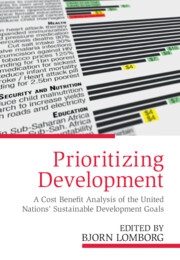 Prioritizing Development
Prioritizing Development Published online by Cambridge University Press: 30 May 2018
Because of the difficulties involved, I sympathize with Fearon and Hoeffler's general approach of trying to highlight certain relevant costs rather than coming up with specific cost-benefit ratios. However, I think the discussion would benefit from a slightly different perspective, taking a further step back to define specific issues of paramount importance together with promising interventions because any attempt to paint a broad picture inevitably becomes somewhat fragmented and superficial. Considering which issues could deliver potentially the highest benefits and be tackled by fairly standardized interventions, I believe the focus should be on common crime and violence.
The authors correctly stress that deaths from common crime in societies subject to chronically high levels of violence far outweigh mortality from civil and military conflicts. One point overlooked is the heterogeneous nature of both civil conflicts. In particular, because civil conflicts have political origins, it is difficult to conceive of standardized interventions that would be acceptable to all parties. Addressing common crime, on the other hand, would benefit virtually the entire population of affected countries.
What distinguishes societies subject to chronically high violence is an astonishingly high fatality rate for young men. High levels of common crime seem to be closely connected to socioeconomic conditions and state policy, whereas violence against women and children usually has more of a cultural nature.
We can think of an “equilibrium level” of crime set by balancing the potential supply of criminals with repressive state policies. Most public security policies focus on the latter side of the equation, but interventions with improved socioeconomic conditions and job prospects can also help. Overall costs of crime can be calculated, but from a policy perspective, we should be comparing marginal benefits to marginal costs, for example, the social value of spending an extra dollar to reduce the likelihood of homicides. To assess this, we can use either marginal willingness to pay or contingent valuation, but these methods can still miss some of the most harmful dimensions of the cost of crime, such as the reduction of the quantity and quality of investment in education. There is also a problem with trying to scale numbers from country to country for comparison, which may not be valid.
To save this book to your Kindle, first ensure [email protected] is added to your Approved Personal Document E-mail List under your Personal Document Settings on the Manage Your Content and Devices page of your Amazon account. Then enter the ‘name’ part of your Kindle email address below. Find out more about saving to your Kindle.
Note you can select to save to either the @free.kindle.com or @kindle.com variations. ‘@free.kindle.com’ emails are free but can only be saved to your device when it is connected to wi-fi. ‘@kindle.com’ emails can be delivered even when you are not connected to wi-fi, but note that service fees apply.
Find out more about the Kindle Personal Document Service.
To save content items to your account, please confirm that you agree to abide by our usage policies. If this is the first time you use this feature, you will be asked to authorise Cambridge Core to connect with your account. Find out more about saving content to Dropbox.
To save content items to your account, please confirm that you agree to abide by our usage policies. If this is the first time you use this feature, you will be asked to authorise Cambridge Core to connect with your account. Find out more about saving content to Google Drive.